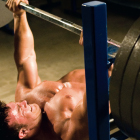 Q: I’ve been bodybuilding for nearly a year. For the past few months I’ve been doing sets of eight to 10 reps on three exercises each for chest and back training, but my progress has stagnated and I’m getting frustrated. Should I increase to 12 to 15 reps, or go down to six to eight?
Q: I’ve been bodybuilding for nearly a year. For the past few months I’ve been doing sets of eight to 10 reps on three exercises each for chest and back training, but my progress has stagnated and I’m getting frustrated. Should I increase to 12 to 15 reps, or go down to six to eight?
A: You have the right idea—when a specific repetition bracket is not working, try a different one. Both 12 to 15 and six to eight reps will provide variety, but since you’ve hit a slump, how about going even lower with three to five reps?
The lower reps will develop the fast-twitch, type 2b muscle fibers, which display the greatest power production and low-level resistance to fatigue. One of the benefits of low-rep training is that when you come off a cycle of low reps, you will be able to use heavier weights. That creates more muscle tension, which in turn leads to a greater growth response.
Here is a lower-rep chest and back workout designed to activate those type 2b muscle fibers.
A1) 45 degree incline-bench presses with chains, 4/0/X/0 tempo, 5 x 3-5
Rest 120 seconds
A2) Thick-bar pullups (medium pronated grip), 4/0/X/0, 5 x 3-5
Rest 120 seconds
B1) V-bar chest dips, 4/0/X/0, 5 x 3-5
Rest 120 seconds
B2) T-bar rows (medium neutral grip), 4/0/X/0, 5 x 3-5
Rest 120 seconds
Let’s break that down.
You perform this workout twice a week for four weeks, for a total of eight training sessions. Make sure there are at least two days of rest between workouts; suggested workout days could be Monday and Thursday or Monday and Friday. That will give you more complete recovery between sessions, which is necessary due to the intensity (i.e., how much weight you lift) of the workout.
You superset exercises A1 with A2 and B1 with B2. Specifically, you pair a horizontal pressing exercise with a vertical pulling exercise and a vertical pressing exercise with a horizontal pulling exercise. That combination works well because you’re stimulating the muscles from a greater variety of angles.
You perform the incline-bench press with chains, which slows down the lift— as the chains lift off the floor, the weight on the bar gets heavier to match. In effect, the resistance curve of the exercise matches the strength curve of the muscles. Even though you are pressing the weight off your chest as fast as you can (X tempo), the increased resistance at the top of the movement will cause the bar to move more slowly.
You perform the pullups with a thick bar. If your gym doesn’t have a thick chinup bar, you can use a pair of Fat Gripz™, which are nonslip, dense foam-type devices that attach to narrow chinup bars to convert them into thick bars. To give you an idea of how effective thick-bar training is for pullups, let me tell you about the experience of a female judo athlete who could perform five -pullups. I put athletic tape around the bar and had her perform 5×5 pullups twice a week. Prior to each workout I would wrap another piece of tape around the bar, making it thicker. At the end of five weeks, when she returned to using the regular grip, she could do five pullups with 45 pounds attached to her waist. She went on to win the United States Open in her sport.
For the chest dips I like the V-bar apparatus because it accommodates a greater variety of body types. As your dipping strength increases, you will need to increase resistance by one of these three methods: have a training partner pull down on your ankles, hold a dumbbell between your ankles or use a chin/dip belt (although the belts used by mountain climbers will also work). Holding a dumbbell securely is more difficult to coordinate than using a belt, and eventually the weights you will use on this exercise will become too heavy to hold in that manner.
For the T-bar rows I would prefer that you use an apparatus that has a chest pad. I don’t generally recommend bent-over barbell rows from a standing position because you’ll expend too much neural drive in firing the erector spinae, glutes and hamstrings while trying to maintain good posture.
Give this workout a try, and then start to look into longer-term planning of your workouts to help you achieve your goals faster.
Editor’s note: Charles Poliquin is recognized as one of the world’s most suc-cessful strength coaches, having coached Olympic med-alists in 12 different sports, including the U.S. women’s track-and-field team for the 2000 Olympics. He’s spent years researching European journals (he’s fluent in English, French and German) and speaking with other coaches and scientists in his quest to optimize training methods. For more on his books, seminars and methods, visit www.CharlesPoliquin.com. IM




















You must be logged in to post a comment Login